
This Month in the History of Astronomy - February
- Feb 4, 1906 - Clyde Tombaugh, who discovered Pluto
in 1930 (see below).
- Feb 7, 1824 - William Huggins, pioneer British spectroscopist
and astrophysicist, whose science was decades ahead of his equipment.
Using a backyard observatory 8" refractor located outside London and
visual observations he first showed (1863) that the spectra of stars
revealed them to be made of the same elements as were known to the
chemist in the laboratory, and that stars were dense, incandescent
objects surrounded by a cooler but still hot atmosphere of gas.
Next (1864), he turned to the 'nebulae', some of which had been
resolved into clusters of stars with better telescopes, and found
the one in Draco now known as NGC 6543 had, instead, an emission
line spectrum, indicating a luminous cloud of hot, rarefied gas,
not stars.
He then discovered two new emission lines in the Orion Nebula, and
proposed a previously unknown element ("nebulium") since these had
not been seen in the laboratory. It would be 63 years before these
were recognized by Ira Bowden as 'forbidden' lines of ionized
nitrogen and oxygen requiring conditions so close to a perfect
vacuum that they couldn't be created artificially in the lab.
Observing the nova of May 18, 1866, he saw a composite spectrum,
with emission lines superposed on a stellar spectrum, indicating
the brightening was accompanied by the expulsion of gas hotter
than the star. This was also the first observation of carbon
bands in the spectrum of a nova. Decades later it would be
understood this was the result of nova of this sort occurring in
close binary systems where the progenitor is a carbon rich white
dwarf star -- essentially the core of a burned out red giant star
which has fused all its hydrogen into helium and then all its
helium into carbon (and oxygen) before loosing its outer layers.
Huggins next (1868) turned to the spectral Doppler shift and tried
to make a radial velocity measurement for a star, using the F line
of hydrogen in the spectrum of Sirius. Due to his relatively crude
equipment and its low wavelength resolution the measurement was
beyond his capability, and he got an answer that was almost 10x
too high, but the velocity of 170,000 kilometers per hour was
incredible for the time. That same year he observed a comet and
ID'd the lines in its spectrum as indicating the presence of
hydrocarbons (see also Aug 5).
During the next ~30 years he developed an ultraviolet spectrograph
-- early photographic emulsions were only sensitive to short
wavelength UV and blue light -- and in 1899, with his wife, he
published an Atlas of Representative Stellar Spectra. From
1900-05 he was president of the Royal Society.
- Feb 7, 1889 - The Astronomical Society of the Pacific,
first national astronomy organization in the U.S..
- Feb 11, 1911 - Carl Seyfert, American astronomer known
for first studying and calling attention, in 1943, to active
galactic nuclei (centers of galaxies) found in a small percentage
of spiral galaxies now named after him as a class, as well as an
unusual grouping of galaxies in which one member has a discrepant
radial velocity, 5x that of the other five galaxies, now known as
Seyfert's Sextet (1951).
Seyfert galaxies have very bright, usually bluish cores which have
a high excitation, non-thermal, emission spectrum and their broad
lines suggest gas (or cloud) motions of several thousand kilometers
per second (-for Type I's, 10x less that for Type II). The brightness
of these galactic nuclei can also be variable on time scales of years.
In many ways, Seyfert nuclei resemble quasars, being at the lower end
of an energy spectrum which makes the latter visible at much greater
distances.
NGC 1068, in 1908, was first such galaxy noticed, by Edward A. Fath
and Vesto Slipher at the Lick Observatory, to have bright emission
lines (six of them), and both it and two other such galaxies were
studied by Edwin Hubble in 1926.
- Feb 13, 1852 - J.L.E. Dreyer, Danish-born Irish astronomer
who compiled the New General Catalogue (NGC) published in 1878, the
last such catalog of "fuzzy objects" across the sky which was made
with visual observations before photography became widely applied
in astronomy.
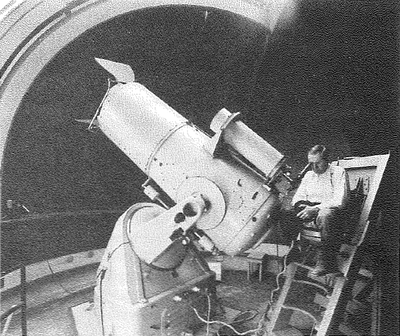
- Feb 14, 1898 - Fritz Zwicky, who first identified supernovae
(SNe) as a separate class of objects and suggested the possibility of
both neutron stars and dark matter.
Zwicky was the first astronomer to observe on Mount Palomar and was
the father of the sky survey technique. He almost single-handedly
constructed the wide field 18" Schmidt camera to search for SNe,
and he discovered over 100 with it, as well as gathering the first
evidence for dark matter from observations of clusters of galaxies.
[Photo at right from 1937.]
The famous Comet Shoemaker-Levy 9 (which crashed into Jupiter) was
discovered with this instrument in 1993. (See Jul 16)
He also designed both solid rocket motors and missile guidance systems
during WWII for the early southern California aerospace industry, and
has his name on numerous patents as a result. Zwicky was adamantly
Swiss, even though he lived and worked in Pasadena for forty years,
and was the first non-U.S. citizen ever to be awarded the Medal of
Freedom (by Truman). He was one of only a handful of scientists at
his level sent to investigate both the German V-2 rocket factories
and the aftermath of the Hiroshima and Nagasaki atomic bombings
immediately following the end of WW II. After the Cold War hysteria
of the 1950s hit -- McCarthyism, the sacking of J. Robert Oppenheimer
for his having opposed the development of the H-Bomb, xenophobic
patriotism, etc. -- Zwicky was increasingly unable to work on "top
secret" stuff and was relegated to being in charge of Pasadena's
civil defense planning and preparedness.
From 1961-68 he completed his Catalogue of Galaxies and of Clusters
of Galaxies in six volumes, many of these objects being known now
by their Zwicky numbers.
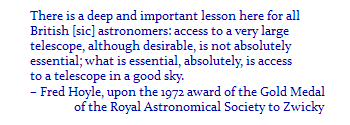
- Feb 14, 1904 - Boris Vorontsov-Vel'laminov, Russian
astronomer who, independently of Trumpler in the U.S., demonstrated
the absorption of starlight by interstellar dust in 1930. From 1934
on he was a professor at the University of Moscow, where he authored
several excellent textbooks, at both the introductory and advanced
levels. Besides work on gaseous nebulae (especially planetary nebulae),
novae, the Hertzsprung-Russel diagram, massive hot stars, and the
evolution of stars in general, he's probably best known now for his
1959 catalog of 350 perturbed and presumably interacting close pairs
of galaxies, which are still sometimes seen designated by their "VV"
numbers; his more general 1962 catalog listed 30,000 galaxies.
- Feb 15, 1564 - Galileo Galilei, first scientist to use
a telescope for astronomical observation, making many important
discoveries. (see Jan 4)
- Feb 16, 1786 - Francois Arago, pioneer scientist in the
wave nature of light and the inventor of the polarimeter and other
optical devices.
- Feb 19, 1473 - Nicholas Copernicus, creator of the modern
solar system by showing how the retrograde motion of the outer planets
was a natural feature of a system in which the planets go around the
Sun.
- Feb 20, 1844 - Ludwig Eduard Boltzmann, Austrian physicist
and namesake of the constant "k" used throughout astrophysics.
Boltzmann's work on the kinetic theory of gases (statistical
mechanics) tells us how the properties of matter on a small scale
determine macroscopic properties like temperature and pressure.
In 1869 in Heidelberg he worked with Robert Bunsen (of Bunsen burner
fame) and then, in 1871, with Gustav Kirchhoff and Hermann von
Helmholtz in Berlin, two greats in the history of thermodynamics.
He became Professor at the University of Graz and taught later
chemistry greats Svante Arrhenius and Walther Nernst; it was also
here that he developed his statistical concept of matter, quantum
physics and atomic theory being yet a decade or two still in the
future. Later, as professor in Vienna, he had Paul Ehrenfest and
Lise Meitner as students.
In 1906 Boltzmann hanged himself. His tombstone bears the inscription
of his entropy formula (second law of thermodynamics):
S = k · log W
In galaxy dynamics the collisionless Boltzmann equation,
df/dt=0, expresses the idea that the flow of the probability fluid,
which can be used to represent stars, through phase space is
incompressible.
- Feb 22, 1824 - Jules Janssen, French astronomer
and solar spectroscopist, who was director of the new (1875)
observatory at Meudon for the next 30+ years.
Previously, having heard about Kirchoff's 1859 identification
of terrestrial elements in spectra of the Sun, Janssen launched a
study of the dark bands in the Sun's spectrum, now called
"telluric rays", and showed they were of terrestrial origin,
varying with both altitude and humidity, as well as the path
length through the atmosphere ("air mass"), at the time of
observation. In 1867 he used similar techniques with a telescope
in the Azores to first discover water vapor in the atmosphere of
Mars.
Janssen was part of the scientific team at the historic eclipse
in India in 1868 (Aug 18), noting a third yellow emission line
in the spectrum of the chromosphere (the first two being due to
sodium), which British astronomer and spectroscopist Norman
Lockyer virtually simultaneously with Janssen proposed must
be due to an unknown element in the Sun, called helium, but
not found on earth for another three decades.
That same year he developed a spectrohelioscope for studying
the Sun during the daytime and without an eclipse, and
established an observatory on Mount Blanc to minimize the
effects of the earth's atmosphere, the beginning of a trend
in siting telescopes on mountaintops, which now seems
self-evident. Janssen's photographic atlas of the Sun
(1904), about the first of its kind, was based on observations
covering 28 years. Two scientific prizes carry Janssen's name:
one from the French Astronomical Society and the other from
the French Academy of Sciences.
- Feb 26, 1842 - Camille Flammarion, prolific and widely
read 19th century popularizer of astronomy and the notion of there
being extraterrestrial life.
- Feb 27, 1897 - Bernard Lyot, inventor of the coronagraph
in 1930.
Discoveries and other firsts
- Feb 3, 1966 - First soft landing on the Moon, by the
Soviet Luna 9.
- Feb 4, 1600 - The first meeting between Tycho Brahe
and Johannes Kepler, in Prague. The two had corresponded before,
as Kepler had sent Brahe a copy of his 1597 book Mysterium
Cosmographicum ("The Cosmic Mystery"). (A copy also found its
way into the hands of Galileo Galilei.) The meeting led to Kepler's
moving to Prague in October as Brahe's assistant. This would last
only a year, as Brahe died in October of 1601. Kepler then inherited
his mountains of observations, particularly of Mars, this solid body
of experimental data giving Kepler the basis for developing the first
two of his three laws of planetary motion over the next couple of
years, involving many hundreds of sheets of arithmetic and their
interpretation. The third law would not appear until almost 20 years
later.
- Feb 5, 1963 - The first quasar redshift was measured, by
Maarten Schmidt, who was seeking optical identification of radio
sources. Hence the quasar is named 3C 273 (#273 in the 3rd Cambridge
catalog of such sources), and it had an unimaginably high redshift
of z=0.158 (47,400 km/sec) for the time. It was only shortly later
that Jesse Greenstein, also working with spectra taken with the 200"
telescope at Mount Palomar, found 3C 48 to have z=0.37, thus clinching
the case for quasars (which is short for "quasi-stellar radio source")
being an extraordinary class of objects.
- Feb 5, 1974 - Mariner 10 makes the first close-up photos
of Venus.
- Feb 6, 1970 - A newly hired night assistant at the
2.7-meter telescope of the McDonald Observatory in Texas goes
berserk with a 9mm pistol, firing 7 shots point-blank at the
primary mirror. No damage was done to the 4 ton mirror's
figure, but chips 2½-4" in diameter were taken out
of its surface; when masked off these reduced the telescope's
light gathering power by less than 1%.
- Feb 6, 1971 - Both the first color TV pictures were sent
back from, and the first golf shots were taken on, the Moon, by
Apollo 14 astronauts (Alan Shepherd in the latter instance).
- Feb 6, 2011 - NASA's twin Solar Terrestrial Relations
Observatories (Stereo A & B), which were launched in 2006, first
reached a point 180° apart from each other in their orbits
around the Sun, giving us the first 360° view of our star
ever. Contact was lost with Stereo B 3½ years later (10/1/14)
but was reestablished 22 months after that (8/21/16); a failed
inertial measurement unit makes it uncertain whether it will be
possible to resume science operations.
- Feb 6-8, 1946 - The largest sunspot group ever recorded
up to that time, covering ~1% of the surface of the Sun, created an
intense solar outburst at radio wavelengths which allowed Joseph L.
Pawsey and his group at the Radiophysics Laboraory in Australia,
working at 200 MHz, to deduce that the emitting region was 8-13
arc-minutes in size, showing that the radiation likely came from
the active regions and not from the sun as a whole.
Radar researchers during WWII had surmised that excess noise in
their systems was due to the Sun (or Milky Way), and only a few
months earlier they had shown that the radio noise from the Sun,
which varied by 30x over just a few weeks, correlated well with
the percentage of area on the Sun covered by spots.
- Feb 10, 1958 - Radio astronomers at MIT's Lincoln
Laboratory bounced radar waves off of Venus for the first time.
Venus was at inferior conjunction, about 28 million miles from
earth, so the round trip travel time for the waves was a little
less than 5 minutes. Venus was very slightly closer than
expected, so the time measurement translated into a slightly
smaller new value for the astronomical unit (AU).
- Feb 11/12, 1970 - Lambda 4S-5, first Japanese satellite
launched.

- Feb 14, 1990 - Voyager 2 takes the famous "pale blue
dot" photo, looking back at an Earth which only fills one pixel
at a distance of 40¼ AU, i.e., after flying by Neptune.
- Feb 15, 2013 - A very bright meteor explodes over
Chelyabinsk, Russia. Thought to have been only ~20 meters
in diameter, but weighing more than 10,000 tons, about 1,500
people were injured seriously enough to seek medical treatment,
mainly from broken glass from windows that were blown in when
the shock wave arrived; some 7,200 buildings in six cities
across the region were damaged. A nearly ¾ ton fragment
was recovered from nearby Lake Chebarkul after a hole in the
ice surrounded by small meteorite fragments was noted. Later,
a security video was discovered to have recorded this impact,
the first time in history this was done; calculations show it
hit at ~64% the speed of sound.
- Feb 16, 1948 - Uranus's moon Miranda is discovered by
Gerard Kuiper (see also Dec 7 &
May 1).
- Feb 17, 1985 - Almost 55 years after Pluto's discovery,
the first in a series of mutual eclipse events in the Pluto-Charon
binary planet system is detected by R.P. Binzel at the McDonald
Observatory.
Charon had only been discovered half a dozen years earlier (see
Jun 22), and shortly after a very
uncertain orbit for Charon had been determined L.E. Andersson
realized the earth would go through the plane of its orbit twice
every orbit of Pluto around the sun, or every 124 years, starting
in 1983-86 -- if it hadn't already happened in the 1970's, just
before Charon's discovery. At that time, Pluto's radius was
uncertain by a factor of 4 and its mass by a factor of 100.
The first eclipse, causing a dimming of only ~0.01-0.02 magnitudes,
was confirmed half a Charon orbital period (three days) later by
D.J. Tholen at Mauna Kea.
The series of mutual eclipses lasted until October, 1990, and with
many dozens of observations during the years allowed the determination
of the masses and sizes of both objects to within a few percent, the
density of the system (2.03 gm/cm3 ±10% -- suggesting
these objects are dominated internally by rocky material), and as well
a very accurate orbit for Charon. The very existence of the eclipses
and their progression in depth as the plane of Charon's orbit pointed
more directly at earth showed Charon itself was a satellite and not
merely some strange topographic feature on the surface of Pluto.
- Feb 18, 1930 - Pluto is found by Clyde Tombaugh
(see above) during a search of plates taken
with the Lowell Observatory (Flagstaff) 13" telescope. Tombaugh
had been at the task for a year, and the discovery plates had
been made 3-4 weeks earlier (Jan 23rd & 29th).
Seth Nicholson and Nick Mayall at Mount Wilson computed the first
decent orbit for Pluto, based on 13" x 17" plates made with a 10"
f/4.5 Cooke triplet lens in Dec 1919. Nicholson had been there
when they were taken and so knew of their existence, and
observations made with the Mt Wilson 60" telescope shortly
after discovery allowed back-tracking Pluto's position to find
it on the earlier photos. Nicholson pioneered the use of the solar
system's barycenter for calculating the perturbations to Pluto's
orbit from the major (outer) planets, allowing its position to be
determined to within a couple of arc-seconds going back decades.
Observatories around the world were then able to search through their
plate collections. Max Wolf at Heidelberg found one from 1914 taken
with a short-focus camera. The earliest pre-discovery photo of Pluto
turned out to have been taken on Aug 20, 1909, at the Yerkes
Observatory, which extended the time baseline to two decades. Lowell
Observatory itself had photographed Pluto as early as Mar 19 and Apr
7, 1915 -- a half dozen years into Lowell's search for a hypothetical
Planet X -- but it had not been recognized then.
- Feb 19, 1958 - Juno passes in front of the star SAO 112328,
the first such occultation of a star by an asteroid ever observed.
- Feb 20, 1962 - John Glenn aboard Friendship 7 orbits the
earth three times, first for an American.
- Feb 21, 1901 - Nova Persei (GK Persei) was first spotted
by the Scot Thomas Anderson. It reached the bright magnitude of 0.2,
or ½ magnitude brighter than Saturn. By the next year a small
expanding nebula surrounding it had been photographed at both the
Lick and Mount Wilson observatories with the new large telescopes
and photographic plates, which prompted speculation as to whether
the nebula was an expanding cloud or just a "light echo" hitting
material that had been expelled much earlier and was already in
place at the time of the explosion. After expanding for more than
a century it is now known as the Fireworks nebula.
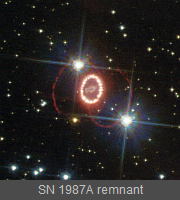
- Feb 21, 1955 - the hydrogen Lyman-alpha line, at
1,216Å in the vacuum ultraviolet, is first recorded in
the sun's corona during a rocket flight to an altitude of 117
km over New Mexico; the photography required a special emulsion
because gelatin absorbs hard UV, so the silver halide grains
had to be embedded in the film's surface.
- Feb 22, 2001 - The most powerful volcanic explosion
ever observed in the solar system is seen on Jupiter's moon Io.
- Feb 23, 1987 - SN1987a, the brightest supernova visible
from earth in 383 years, is discovered in the Large Magellanic Cloud
visually by Canadian Ian Shelton in Chile. [Hubble Space Telescope
photo c.2011 at right]
- Feb 24, 1968 - The first pulsar was discovered, by Jocelyn
Bell, in a radio search survey. Hewish and Ryle, co-directors of the
project, got the 1974 Physics Nobel Prize for matching the observations
to a model of a rotating neutron star. This had first been explored
theoretically thirty years earlier by J. Robert Oppenheimer, who
in the interim became famous as the leader of the Los Alamos lab
which developed the A-bomb during WWII and, later, as the victim
of McCarthy era politics.
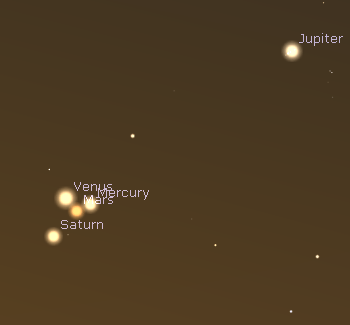
- Feb 26, 1953 B.C. - "The tightest conjunction of planets
ever witnessed by civilization" -- Mercury, Venus, Mars, and Saturn
all within an area ½° across -- discovered in the early
1990s by Neil de Grasse Tyson, using then new "planetarium program"
software, after being approached by a scholar of ancient Chinese
culture who suspected some major sky event c.1950 B.C. was behind
other events he was investigating. Jupiter was only 4½°
away, and four or five days later a waning crescent moon would join
the conjunction in the early dawn sky. [Graphic at right from
Stellarium v.17.0]
- Feb 26, 1979 - During an eclipse of the sun, Alan Clark
and Rita Boreiko use a NASA learjet to observe limb occultation of
the sun's chromosphere in the far infrared for the first time.
Yours truly's near-infrared (also called the "photographic infrared")
observation of the corona illuminated landscape 7 miles NNE of
Grassrange, Montana, during totality of the same eclipse, looking
generally W-WNW, so in the far distance at the left you can see the
area of sky outside the moon's shadow; this was a five second time
exposure on 4x5 Kodak High Speed Infrared film (#4143), and was a
crude but simple attempt to measure the integrated near-IR brightness
of the corona from the illumination level of the landscape:
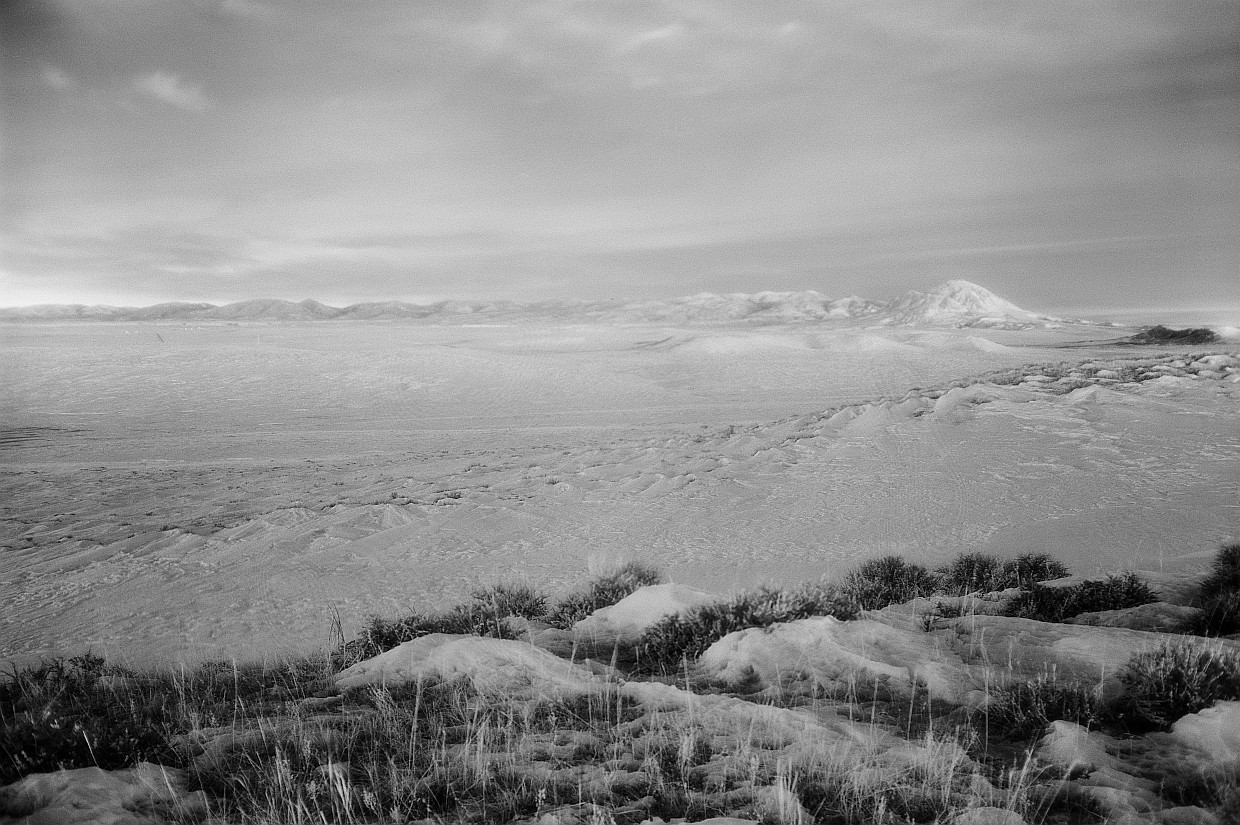

©2002-2025, Chris Wetherill. All rights reserved. Display
here does NOT constitute or imply permission to copy, republish,
or redistribute my work in any manner for any purpose without prior
written permission.

[ Back to January ||
On to March ]
[ To: History Directory ||
Main VISNS page ]







